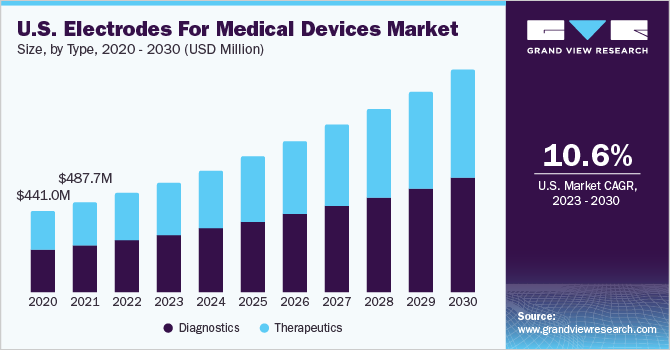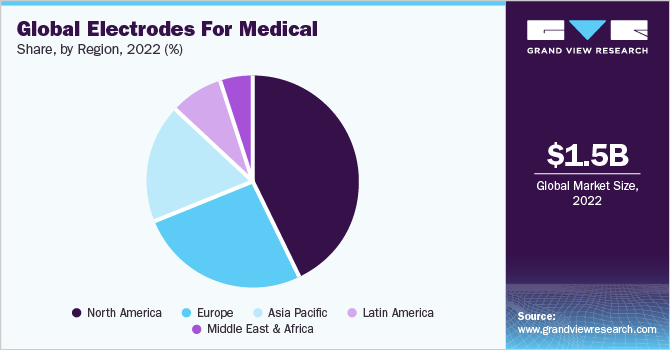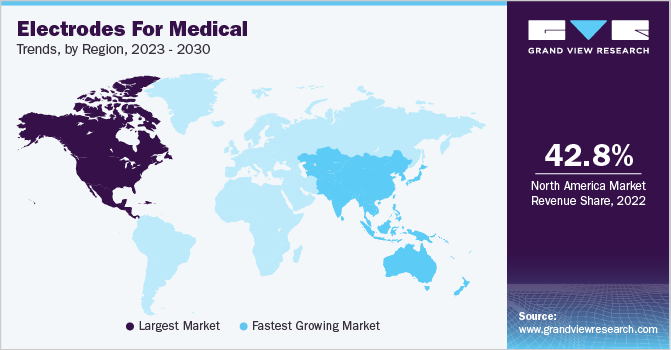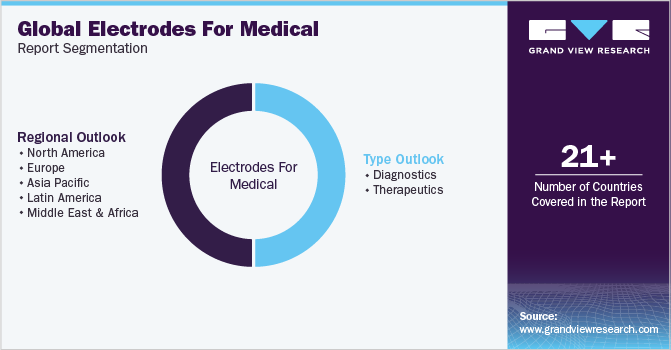- Home
- »
- Medical Devices
- »
-
Electrodes For Medical Devices Market Size Report, 2030GVR Report cover
![Electrodes For Medical Devices Market Size, Share & Trends Report]()
Electrodes For Medical Devices Market Size, Share & Trends Analysis Report By Type (Diagnostics, Therapeutics), By Region (North America, Europe, Asia Pacific), And Segment Forecasts, 2023 - 2030
- Report ID: GVR-1-68038-913-5
- Number of Report Pages: 100
- Format: PDF, Horizon Databook
- Historical Range: 2018 - 2021
- Forecast Period: 2023 - 2030
- Industry: Healthcare
Report Overview
The global electrodes for medical devices market size was valued at USD 1.46 billion in 2022 and is expected to grow at a compound annual growth rate (CAGR) of 11.2% from 2023 to 2030. The increasing prevalence of Alzheimer’s, Parkinson’s Disease (PD), tinnitus, Raynaud's disease, fibromyalgia, heart disorders, brain disorders, circulatory disturbances, body aches, and an increase in number of surgeries are expected to drive the market. Also, the availability of technologically advanced medical electrodes and increasing demand for portable devices are key drivers that are likely to govern market growth worldwide.

According to the Parkinson's Disease Foundation, more than 10 million people worldwide are living with Parkinson’s disease. Near 1 million people in the U.S. are living with Parkinson’s Disease (PD) and it is estimated to reach 1.2 million by the year 2030. Parkinson’s is now the second most common neurodegenerative disease after Alzheimer’s disease. The primary risk factor for Parkinson’s disease is considered to be age, thus it is more prevalent in Europe and China. The increasing prevalence of these diseases is anticipated to propel the market growth over the forecast period.
The surge in chronic diseases and the increasing prevalence of neurological disorders and heart diseases is expected to fuel market growth. According to the World Heart Federation (WHF), 1.3 billion people around the world have hypertension and it accounts for about half of all heart disease and stroke-related deaths worldwide. Electrodes are beneficial for stroke patients as when they are placed on the skin, they can provide electrical stimulation by sending mild electrical impulses to activate damaged portions of the brain.
According to the World Health Organization (WHO), epilepsy is one of the most common chronic brain diseases, which can occur in people of any age group. More than 50 million people around the world have epilepsy, out of which around 80% live in middle and low-income nations. Also, according to the British Heart Foundation (BHF), around 7.6 million people in the UK are living with heart and circulatory diseases. The high mortality risk associated with these types of diseases increases the rate of medical diagnosis of patients which is eventually driving the market. Portable medical devices are gaining traction globally as they offer benefits such as remote monitoring and extended care from the doctor’s clinic at the patient’s home in case of management of chronic diseases.
Several initiatives & campaigns being carried out by various governments around the world are spreading awareness among people about chronic diseases. For instance, The Government of India (GOI) launched a national multi-sectorial action plan for the prevention and control of common non-communicable diseases (2017-2022). Also, in August 2021, The Ministry of Health and Prevention UAE launched a campaign on the danger of obesity, chronic diseases, and its connection with COVID-19. This kind of initiative can spread awareness about non-communicable diseases and can be beneficial for the market.
Type Insights
The diagnostics segment dominated the market in 2022. There has been an increase in the number of cardiovascular, neurological, and sleep disorders in the last few years, which has led to an increase in the number of diagnostics procedures being carried out around the world. The diagnostic segment is further sub-classified into Electrocardiogram (ECG), Electroencephalogram (EEG), Electromyogram (EMG), Electroretinogram (ERG), fetal scalp, and others. The ECG segment held the largest revenue share of 32.6% in 2022 & ERG is expected to show the largest CAGR of 12.4% in the forecasted period.
The therapeutics segment is expected to grow at the fastest CAGR during the forecasted period. Therapeutics segment is further classified into pacemakers, Transcutaneous Electrical Nerve Stimulators (TENS), defibrillators, electrosurgical, and others. According to the World Health Organization (WHO), cardiovascular diseases are one of the leading causes of death across the world, an estimated 17.9 million people died from CVD in 2019, which accounted for around 32% of all global deaths. This increasing prevalence is leading to a surge in demand for pacemaker electrodes and is anticipated to register a significant CAGR during the forecast period.
Regional Insights
North America held the largest revenue share of 42.8% in 2022 due to the increasing prevalence of CVD in the region, the changing lifestyle of individuals, health awareness among people, and the presence of the target audience in the U.S. and Canada. The U.S. alone accounted for 86.6 % of revenue share in the North America region.

North America and Europe are the largest contributors to the electrodes for medical devices market, owing to the growing focus on regular technological advancements in the electrodes, the rising older age population, high expenditure in the healthcare sector, and the presence of key players in the region. In May 2023, NeuroOne announced the launch of its “Evo sEEG” electrodes in the U.S. This technology is expected to offer brain stimulation, and ablation solutions for patients suffering from diseases such as Parkinson’s disease and epilepsy.

Asia Pacific is expected to grow at the fastest CAGR of 12.7% over the forecast period. This can be attributed to the presence of chronic diseases in the region, government initiatives regarding health awareness & surge in investment in the healthcare sector. China is witnessing a rapid rise in the number of non-communicable diseases. CVD is considered to be the single greatest cause of death in China. Several initiatives are now being undertaken by the government in that direction. The Chinese government started an initiative called Healthy China Initiative (2019-2030), which is focused on health education and spreading awareness about non-communicable diseases.
Key Companies & Market Share Insights
The market players are focusing on various growth strategies such as expansion, new product launches, acquisition & merger, and portfolio expansion. In January 2023, Cook Medical announced the launch of a urological bipolar electrodes portfolio, inclusive of a total of 7 products, in the U.S. The streamlined portfolio is expected to help physicians focus on treating patients with the most frequent products that they use during any procedure.
In October 2022, Nihon Kohden launched its new product called Smart Cable NMT Pod & disposable electrode. The device can be used by clinicians to monitor the paralysis depth in patients while performing surgery whenever a neuromuscular blockade agent is administered. In August 2022, NeuroPace announced a commercial deal with a revolutionary diagnostic tool developer, DIXI Medical USA, to distribute its product line in the U.S. As per the agreement, NeuroPace would have exclusive rights to sell and promote stereoelectroencephalography (SEEG) electrodes in the country. Some of the major players in the global electrodes for medical devices market:
-
3M
-
Boston Scientific Corporation
-
GE HealthCare
-
CONMED Corporation
-
Medtronic
-
Natus Medical Incorporated
-
Thermo Fisher Scientific Inc.
-
Asahi Kasei Corporation
-
Koninklijke Philips N.V.
-
X-trodes
Electrodes For Medical Devices Market Report Scope
Report Attribute
Details
Market size value in 2023
USD 1.62 billion
Revenue forecast in 2030
USD 3.42 billion
Growth Rate
CAGR of 11.2% from 2023 to 2030
The base year for estimation
2022
Historical data
2018 - 2021
Forecast period
2023 - 2030
Quantitative units
Revenue in USD million/billion and CAGR from 2023 to 2030
Report coverage
Revenue forecast, company share, competitive landscape, growth factors and trends
Segments covered
Type, region
Regional scope
North America; Europe; Asia Pacific; Latin America; MEA
Country scope
U.S.; Canada; UK; Germany; France; Italy; Spain; Denmark; Sweden; Norway; Japan; China; India; Australia; South Korea; Thailand; Brazil; Mexico; Argentina; Saudi Arabia; South Africa; UAE; Kuwait
Key companies profiled
3M; Boston Scientific Corporation; GE HealthCare; CONMED Corporation; Medtronic; Natus Medical Incorporated; Thermo Fisher Scientific Inc.; Asahi Kasei Corporation; Koninklijke Philips N.V.; X-trodes
Customization scope
Free report customization (equivalent up to 8 analysts working days) with purchase. Addition or alteration to country, regional & segment scope.
Pricing and purchase options
Avail customized purchase options to meet your exact research needs. Explore purchase options
Global Electrodes For Medical Devices Market Report Segmentation
This report forecasts revenue growth and provides an analysis of the latest trends in each of the sub-segments from 2018 to 2030. For this study, Grand View Research, Inc. has segmented the global electrodes for medical devices market based on type and region:

-
Type Outlook (Revenue, USD Million, 2018 - 2030)
-
Diagnostics
-
Electrocardiogram (ECG)
-
Electroencephalogram (EEG)
-
Electromyogram (EMG)
-
Electroretinogram (ERG)
-
Fetal Scalp
-
Other
-
-
Therapeutics
-
Pacemaker
-
Transcutaneous Electrical Nerve Stimulator (TENS)
-
Defibrillator
-
Electrosurgical
-
Other
-
-
-
Regional Outlook (Revenue, USD Million, 2018 - 2030)
-
North America
-
U.S.
-
Canada
-
-
Europe
-
UK
-
Germany
-
France
-
Italy
-
Spain
-
Sweden
-
Norway
-
Denmark
-
-
Asia Pacific
-
Japan
-
China
-
India
-
Australia
-
Thailand
-
South Korea
-
-
Latin America
-
Brazil
-
Mexico
-
Argentina
-
-
Middle East and Africa
-
Saudi Arabia
-
South Africa
-
UAE
-
Kuwait
-
-
Frequently Asked Questions About This Report
b. North America dominated the electrodes for medical devices market with a share of 42.8% in 2022. This is attributable to the rising increasing prevalence of CVDs, changing lifestyles of individuals, and the presence of a huge target population in the U.S. and Canada.
b. Some key players operating in the electrodes for medical devices market include 3M, Boston Scientific Corporation, GE Healthcare, CONMED, Medtronic, Thermo Fisher Scientific Inc., Asahi Kasei Corporation, and Philips Healthcare.
b. Key factors that are driving the market growth include rise in the prevalence of Parkinson’s Disease (PD), heart diseases, Alzheimer’s disease, Trigeminal neuralgia (TN or TGN), sinusitis, and Raynaud's disease, and introduction of technological advancement in medical electrodes.
b. The global electrodes for medical devices market size was estimated at USD 1.46 billion in 2022 and is expected to reach USD 1.62 billion in 2023.
b. The global electrodes for medical devices market is expected to grow at a compound annual growth rate of 11.2% from 2023 to 2030 to reach USD 3.42 billion by 2030.
Share this report with your colleague or friend.
![gvr icn]()
NEED A CUSTOM REPORT?
We can customize every report - free of charge - including purchasing stand-alone sections or country-level reports, as well as offer affordable discounts for start-ups & universities. Contact us now
![Certified Icon]()
We are GDPR and CCPA compliant! Your transaction & personal information is safe and secure. For more details, please read our privacy policy.
We are committed towards customer satisfaction, and quality service.
"The quality of research they have done for us has been excellent."





